
Mineral Point is a city in Iowa County, Wisconsin, United States. The population was 2,581 at the 2020 census. The city is located within the Town of Mineral Point. Mineral Point is part of the Madison Metropolitan Statistical Area.
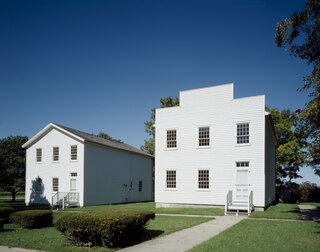
Belmont is a village in Lafayette County, Wisconsin, United States. The population was 989 at the 2020 census. It was the original capital of the Wisconsin Territory during the first legislative assembly in 1836.

The Territory of Wisconsin was an organized and incorporated territory of the United States that existed from July 3, 1836, until May 29, 1848, when an eastern portion of the territory was admitted to the Union as the State of Wisconsin. Belmont was initially chosen as the capital of the territory. In 1837, the territorial legislature met in Burlington, just north of the Skunk River on the Mississippi, which became part of the Iowa Territory in 1838. In that year, 1838, the territorial capital of Wisconsin was moved to Madison.

The Wisconsin State Capitol, located in Madison, Wisconsin, houses both chambers of the Wisconsin Legislature along with the Wisconsin Supreme Court and the Office of the Governor. Completed in 1917, the building is the fifth to serve as the Wisconsin capitol since the first territorial legislature convened in 1836 and the third building since Wisconsin was granted statehood in 1848. The Wisconsin State Capitol is the tallest building in Madison, a distinction that has been preserved by legislation that prohibits buildings taller than the 187 feet (57 m) columns surrounding the dome. The Capitol is located at the southwestern end of the Madison Isthmus in downtown Madison, bordered by streets that make up the Capitol Square.
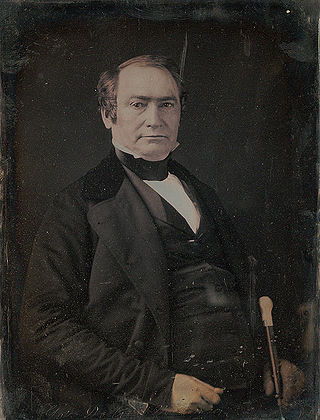
James Duane Doty was a land speculator and politician in the United States who played an important role in the development of Wisconsin and Utah Territory.

Pawnee is a ghost town in Geary County, Kansas, United States, which briefly served as the first official capital of the Kansas Territory in 1855. Pawnee was the territorial capital for exactly five days – the legislature met there from July 2 to July 6 – before legislators voted to move the capital to Shawnee Mission, which is located in present-day Fairway. It may be the shortest-lived capital of any U.S. state or territory.

The Madison Isthmus is where the downtown and near east portion of Madison, Wisconsin is situated, between Lake Mendota and Lake Monona. It is located between Madison's northeast side to the east and the University of Wisconsin campus to the west.
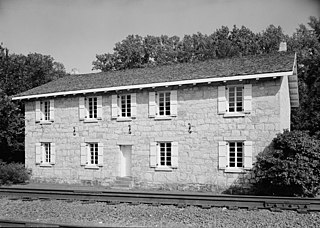
The First Territorial Capitol of Kansas is the sole remaining building of the ghost town of Pawnee, Kansas. The city served as the capital of the Kansas Territory for five days before it was moved to Shawnee Mission and then present day Lecompton, Kansas, and the town became part of neighboring Fort Riley. The building was the meeting place for the first elected Territorial Legislature in 1855. After falling into disrepair, the structure was restored in 1928 and today it serves as a history museum operated by the Kansas Historical Society and supported through The Partners of the First Territorial Capitol.
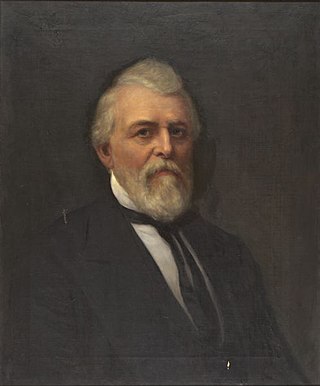
Moses McCure Strong was an American lawyer, politician, businessman, and Wisconsin pioneer. He was one of the framers of the Constitution of Wisconsin, a member of the territorial legislature, and United States Attorney for the Wisconsin Territory under President Martin Van Buren. After Wisconsin achieved statehood, he was speaker of the Wisconsin State Assembly during the 3rd Wisconsin Legislature (1850).

The Belmont Hotel is a twelve-story residential high rise built as a hotel on the Capitol Square in Madison, Wisconsin, in 1924. At that time it was the tallest building near the Capitol, and concern that it blocked the view spurred height-limit restrictions that are still in place. In 1990 the building was placed on the National Register of Historic Places.
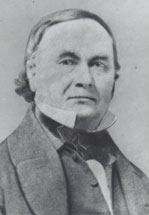
Henry Samuel Baird Jr. was an Irish American immigrant, Wisconsin pioneer, lawyer, and politician. He was the first Attorney General of the Wisconsin Territory, appointed by territorial governor Henry Dodge. He is known as "Father of the Wisconsin Bar," and was said to be the first practicing lawyer in the Wisconsin Territory.
Augustus Allen Bird was an American pioneer and politician. He was the 2nd Mayor of Madison, Wisconsin, represented the Madison area for two terms in the Wisconsin State Assembly, and was one of the commissioners responsible for establishing the first Capitol building located at Madison, Wisconsin, used by the territorial government and Wisconsin Legislature until 1863.
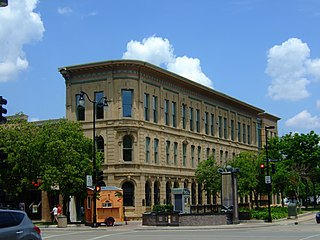
The American Exchange Bank is an Italian Renaissance Revival-style business block built in 1871 in Madison, Wisconsin, and is one of the last such structures left on the Capitol Square. It was added to the National Register of Historic Places in 1980. The bank was also designated a landmark by the Madison Landmarks Commission in 1975.
John Hawkins Rountree was an American farmer, businessman, politician, and Wisconsin pioneer. He was the founder of Platteville, Wisconsin, and was instrumental in the early development of that village. He was also one of the founders of the Northwestern Mutual Insurance Company, and remained a director in the company until his death. In politics, he represented Grant County for five years in the Wisconsin Legislature, and was a delegate to Wisconsin's 2nd constitutional convention in 1847.
Peter Hill Engle was an American lawyer, judge, and Iowa pioneer. He served as the first Speaker of the Legislative Assembly of the Wisconsin Territory after it was established, when it still contained the territory of the future states of Iowa and Minnesota. He later served as a judge of the St. Louis County, Missouri, Court of Common Pleas from 1841 until his death.
Abner Nichols was a member of the Wisconsin State Assembly.
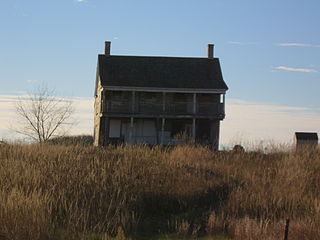
The Prairie Spring Hotel, also known as the Daniel Morgan Parkinson House, was built in 1834 with Greek Revival elements. The structure is located in Lafayette County outside Willow Springs, Wisconsin It was listed on the National Register of Historic Places in 1999.

The Simeon Mills Historic District is a group of seven historic commercial buildings two blocks west of the capitol square in Madison, Wisconsin, constructed from around 1845 to 1887. In 1987 the district was added to the National Register of Historic Places - considered significant for its concentration of 19th century commercial buildings, which is unique in Madison.
The First Legislative Assembly of the Wisconsin Territory convened from October 25, 1836, to December 9, 1836, and from November 6, 1837, to January 20, 1838, in regular session. The Assembly also convened in special session from June 11, 1838, to June 25, 1838.
Jeremiah Smith Jr. was an early settler in what is now Burlington, Iowa but was then in the Iowa District of the Michigan Territory. He worked as a merchant and land speculator, and later became a farmer and grower of fruit trees. He served as a representative for Des Moines County in the Council of the 1st Wisconsin Territorial Assembly, since at that time Iowa was part of Wisconsin Territory, from October 25, 1836, to June 25, 1838.


















